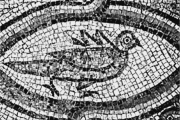Viewings: 5815

These people lived communities, was preparing for the imminent end of the world and inevitably refuge from persecution of Orthodox Christians. The fathers of the Church called them sectarians-Montanelli, apostates and heretics. Working in Turkey foreign archaeologists after much searching found the Holy city of Montanists Pauzu, where the main temple and the monastery of the sect. To the conclusion that found really Pepuza, unanimously reached American Professor Century, Tabern and Professor Peter LAMPE from Heidelberg University in Germany, which together examined the newly discovered ruins.
Somewhere on the Peninsula of Asia Minor, away from the densely-populated coast and from roads on the rocky barren plateau stood revealed "new Jerusalem"spoken of in the Bible. The early Christian community of Montanists revered these remote lands "Holy land." International German-American archeological expedition was looking for "new Jerusalem" more than ten years. The archeologists found the ruins, judging by their age and construction coincide with historical information about the unknown centre of early Christian sects. They were found in remote valley of a small river to the South from the city of Usak by the group of Professor Peter LAMPE and treated, obviously, to the era of the Roman Empire. When the scientists compared the plan of settlement and monastery, carved in the rock, with descriptions of Papusi in ancient sources, they confidently said: "the Mystery of Papusi can be considered resolved".
Pepuza was the center of a powerful prophetic trends in Christianity, which spread into Asia Minor, about 165 A.D. the Founder of the sect was Frigyes Montand. He began performing with sermons in the Phrygian the village of Erdbau and gathered around a hundred students. The new teacher was preaching on "the millennial Empire", in the end, the existence of which in Phrygia will come the Messiah. After the death of the founder of the sect Montana his "Holy spirit" has not left his faithful companions and followers, and spoke to them through gifted with clairvoyance "pronitsatelen". His teaching spread throughout Asia Minor, in Italy and North Africa - there were numerous communities with their priests and strict monastic rule.
The main Shrine of Montanists, spiritual leaders of the sect, the monastery, the relics of their teachers Montana, who is revered as a prophet, - all this was in the "Holy land", in the city Pepuza. Followers of the sect believed Pepuza is the "heavenly Jerusalem", descended from heaven, as predicted in the Bible.
Montanist argued that through them the Holy spirit says
From the dominant Christian Church Montanist differed also by the fact that it was erected in a dignity of priests not only men but also women. The priests and ordinary sectarians-Montanist was putting itself in a state of prayer ecstasy and prophesied. The Holy Church suspected of Montanists committing pagan rites in honor of the Phrygian goddess Cybele. About two hundred years Montanist freely spread its doctrine, but in the IV century the sect has declared heretical, and the zealots began to pursue as the worst enemies of the Christian Church. Around 550 BC the religious center of montanita have been persecuted for heresy: the troops of the Roman Emperor was captured without a fight poorly protected the city. They took a monastery and other buildings belonging to montanita, disintegrated into small pieces massive coffin with the remains of the founder of the sect of Montana, scattered and trampled in the dust of his bones... the Orthodox Church did everything possible to erase from human memory the name and doctrine of odious heretic, so find the destroyed Holy city of Montanists for many centuries an impossible task.
"And I saw a new heaven and a new earth; for the first heaven and the first earth were passed away; and there was no more sea.
And I, John, saw the Holy city, new Jerusalem, coming down from God out of heaven..." - this is written in the book of Revelation (21:1,2). Historians have long known about the early Christian sect of Montanists that did not doubt that the biblical "new Jerusalem" - it is their religious center Pepuza in Phrygia (on the Peninsula of Asia Minor). Could not only determine exactly where he was, after all, Pepuza was destroyed in the middle of the VI century ad, after him in the ancient sources about it, there is no information.
Archeological expedition made in the vicinity of the proposed location of the "new heavenly Jerusalem" intensive survey areas. Archaeologists have identified the area of searches based on the information in the ancient documents. "A clue to an unknown location Papusi was closely associated with the city, the monastery, which is repeatedly mentioned by the ancient literary sources, - said Professor Tabern. - When we got into inaccessible gorge, we first caught sight of the remains of the Roman road and the ruins of the bridge. A little further away were seen extensive ancient cemetery next to the ruins of the city. We climbed on top of one hundred meters above and the dizzying height and saw a large cave monastery carved in the rock complex of monastery buildings with ancient inscriptions on the walls".
"Standing on a rock, you can immediately scan the whole area and learn the signs that exactly matches the ancient descriptions of Papusi", - added the statements colleagues Professor of the Lamp. He is also sure that "new Jerusalem" - an ancient city Pauzu with the monastery sectarian-Montanists - finally found.
















